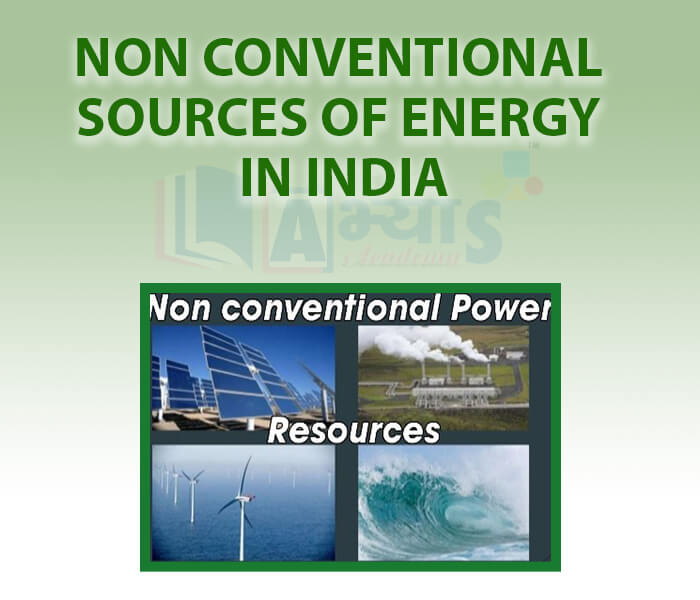Non Conventional Sources of Energy In India










Non Conventional Sources of Energy In India
Non-Conventional Sources of Energy: India is a tropical country that’s why is blessed with an abundance of renewable energy resources. The excessive use of non-renewable resources causes several environmental problems. Hence a shift towards renewable resources is necessary. Some, prominent non-conventional sources of energy are:
a) Nuclear or Atomic Energy: It is generated by transforming the structure of atoms. Due to this alteration heat (energy) generates, which is used to generate electric power. Uranium and thorium are used for generating atomic power. These minerals are available in Aravalli ranges of Rajasthan and Jharkhand. The monazite sands of Kerala is also rich in thorium.
b) Solar Energy: India is a tropical country. It has enormous possibilities tapping solar energy. Solar energy is a freely available resource. It is used for a variety of purposes like electric power generation (using photovoltaic panels) and for heating purposes. Increase use of solar energy contributes to environmental conservation and adequate manure supply in agriculture as it minimises dependence on fire wood and cow dung cakes. India’s largest solar power plant is located in Madhapur near Bhuj in Rajasthan.
c) Wind Power: Wind energy is utilised to turn huge windmills to generate electric power. These have been set-up in the windy areas of the country like the belt between Nagercoil and Madurai in Tamil Nadu as well as in Jaisalmer, Rajasthan. Apart from these, Andhra Pradesh, Karnataka, Gujarat, Kerala, Maharashtra and Lakshadweep have important wind farms.
d) Biogas: It can be produced from shrubs, farm waste, animal and human wastes. Biogas is used as a fuel in rural areas because it has a higher thermal efficiency as compared to kerosene, charcoal or dung cake. It is generated by decomposition of organic matter in biogas plants. Biogas plants can be set-up at municipal, cooperative and individual levels. . These provide benefits to the farmer in the form of energy and improved quality of manure. Biogas is by far the most efficient use of cattle dung. It improves the quality of manure and also prevents the loss of trees and manure.
e) Tidal Energy: Tidal energy is the energy generated by movement of oceanic tides, which can be harnessed to generate electricity. Floodgate dams are built across inlets. During high tide, water flows into the inlet and gets trapped when the gate is closed. After the tide falls outside the floodgate the water inside it flows back to the sea via a pipe that carries it through power generating turbine. In India, the Gulf of Khambhat, the Gulf of Kuchchh in Gujarat on the Western coast and Gangetic delta in Sunderban regions of West Bengal provide ideal conditions for utilising tidal energy.
Geo-thermal Energy: Geo-thermal energy refers to the heat and electricity produced by using the heat from the interior of the Earth. Wherever the concentration of geo-thermal energy is high, higher temperatures are found at shallow depths, leading to the existence of hot springs. To harness energy from hot springs, experimental projects have been set up in India in Parvati valley near in Manikarn Himachal Pradesh and Puga valley in Ladakh
The only off shore oil field in India is ______________________ | |||
| Right Option : D | |||
| View Explanation | |||
Match the following :
| |||||||||||||
| Right Option : A | |||||||||||||
| View Explanation | |||||||||||||
The first explosion of an atomic device was carried out in _________________ | |||
| Right Option : B | |||
| View Explanation | |||
Students / Parents Reviews [10]
It was a good experience with Abhyas Academy. I even faced problems in starting but slowly and steadily overcomed. Especially reasoning classes helped me a lot.

Cheshta
10thMy experience with Abhyas is very good. I have learnt many things here like vedic maths and reasoning also. Teachers here first take our doubts and then there are assignments to verify our weak points.

Shivam Rana
7thAbout Abhyas metholodology the teachers are very nice and hardworking toward students.The Centre Head Mrs Anu Sethi is also a brilliant teacher.Abhyas has taught me how to overcome problems and has always taken my doubts and suppoeted me.

Shreya Shrivastava
8thI have spent a wonderful time in Abhyas academy. It has made my reasoning more apt, English more stronger and Maths an interesting subject for me. It has given me a habbit of self studying

Yatharthi Sharma
10thOne of the best institutes to develope a child interest in studies.Provides SST and English knowledge also unlike other institutes. Teachers are co operative and friendly online tests andPPT develope practical knowledge also.

Aman Kumar Shrivastava
10thAbhyas Methodology is very good. It is based on according to student and each child manages accordingly to its properly. Methodology has improved the abilities of students to shine them in future.

Manish Kumar
10thIt has a great methodology. Students here can get analysis to their test quickly.We can learn easily through PPTs and the testing methods are good. We know that where we have to practice

Barkha Arora
10thA marvelous experience with Abhyas. I am glad to share that my ward has achieved more than enough at the Ambala ABHYAS centre. Years have passed on and more and more he has gained. May the centre flourish and develop day by day by the grace of God.

Archit Segal
7thMy experience was very good with Abhyas academy. I am studying here from 6th class and I am satisfied by its results in my life. I improved a lot here ahead of school syllabus.

Ayan Ghosh
8thBeing a parent, I saw my daughter improvement in her studies by seeing a good result in all day to day compititive exam TMO, NSO, IEO etc and as well as studies. I have got a fruitful result from my daughter.
